Hyundai Accent: Cylinder Head Assembly / Cylinder Head

• Use Fender cover to avoid damaging painted surfaces.
• To avoid damaging the cylinder head, wait until the engine coolant temperature drops below normal temperature before removing it.
• When handling a metal gasket, take care not to fold the gasket or damage the contact surface of the gasket.
• To avoid damage, unplug the wiring connectors carefully while holding the connector portion.

• Mark all wiring and hoses to avoid misconnection.
• Turn the crankshaft pulley so that the No. 1 piston is at top dead center.
1.Disconnect the battery negative terminal.
2.Remove the engine cover.(Refer to Engine and Transaxle Assembly - "Engine Cover")
3.Remove the engine room under cover.(Refer to Engine and Transaxle Assembly - "Engine Room Under Cover")
4.Drain the coolant.(Refer to Cooling System - "Coolant")
5.Drain the engine oil.(Refer to Lubrication System - "Engine Oil")
6.Remove the air duct and air cleaner assembly.(Refer to Intake and Exhaust System - "Air Cleaner")
7.Remove the battery.(Refer to Engine Electrical System - "Battery")
8.Remove the Engine Control Module (ECM).(Refer to Engine Control / Fuel System - "Engine Control Module (ECM)")
9.Remove the battery tray.(Refer to Engine Electrical System - "Battery")
10.Disconnect the radiator upper hose (A).
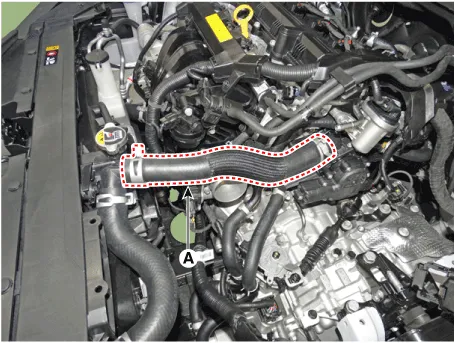
11.Disconnect the brake vacuum hose (A).
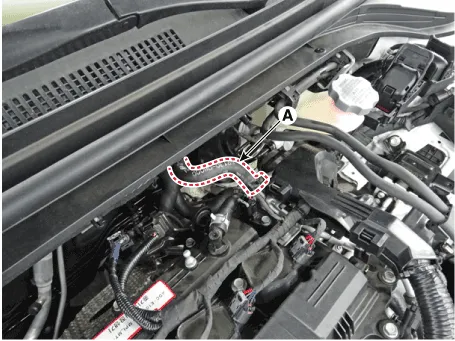
12.Disconnect the fuel hose (A) and purge control solenoid valve (PCSV) hose (B).
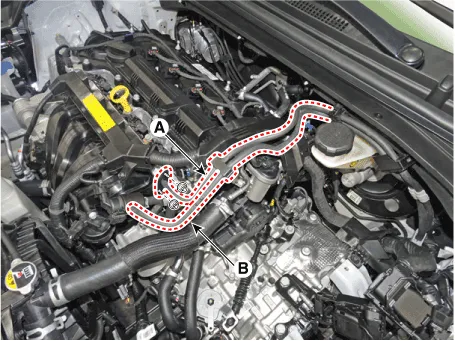
13.Disconnect the heater hoses (A).
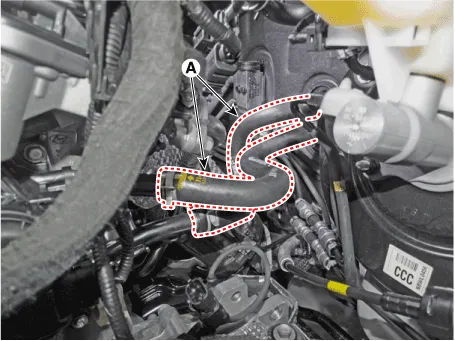
14.Remove the delivery pipe.(Refer to Engine Control / Fuel System - "Delivery Pipe")
15.Remove the intake manifold.(Refer to Intake and Exhaust System - "Intake Manifold")
16.Remove the exhaust manifold.(Refer to Intake and Exhaust System - "Exhaust Manifold")
17.Remove the integrated thermal management module (ITM).(Refer to Cooling System - "Integrated Thermal Management Module (ITM)")
18.Remove the electric EGR control valve.(Refer to Engine Control / Fuel System - "Electric EGR Control Valve")
19.Remove the heater pipe mounting bolt (A).
Tightening torque : 18.6 - 23.5 N.m (1.9 - 2.4 kgf.m, 13.7 - 17.4 lb-ft)
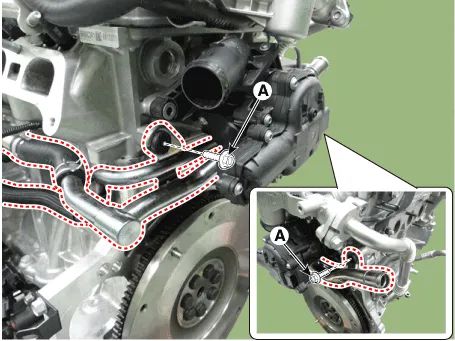
20.Disconnect the water temperature sensor (WTS) connector (A).
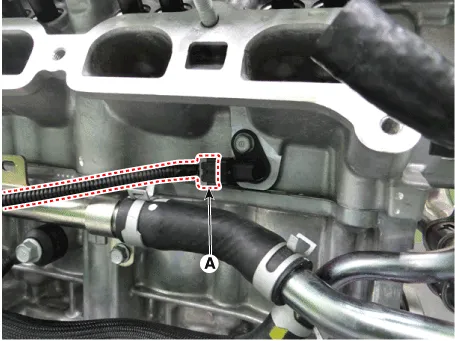
21.Remove the spark plug.(Refer to Engine Electrical System - "Spark Plug")
22.Remove the cylinder head cover.(Refer to Cylinder Head Assembly - "Cylinder Head Cover")
23.Remove the timing chain.(Refer to Timing System - "Timing Chain")
24.Remove the camshaft front bearing cap (A) and camshaft bearing caps (B).
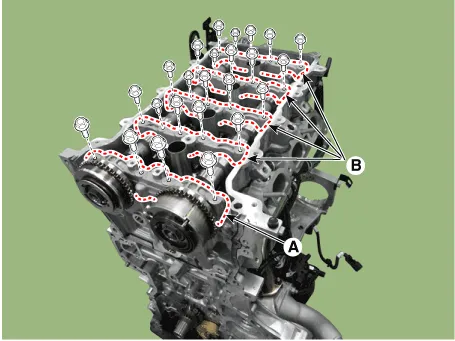
25.Remove the intake CVVT & camshaft assembly (A) and exhaust CVVT & camshaft assembly (B).
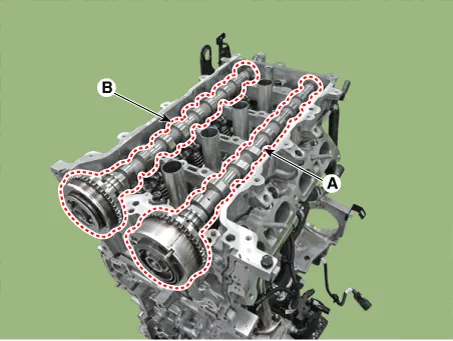
26.Remove the cam carrier (A).
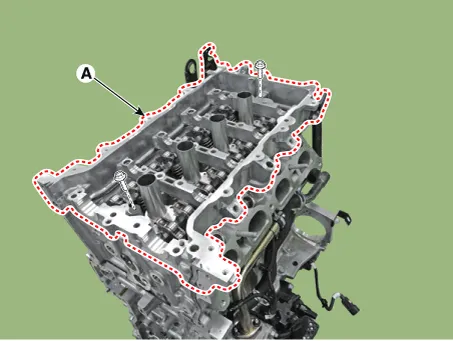
27.Remove the hydraulic lash adjuster (HLA) (A) and swing arm (B).
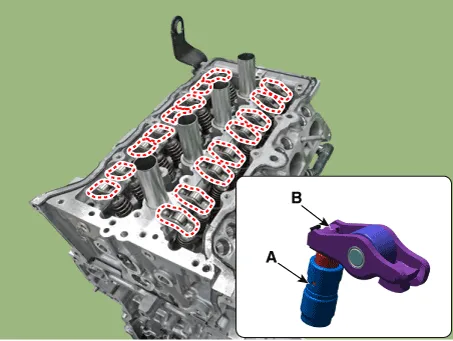
28.Remove the cylinder head.
(1)Uniformly loosen and remove the cylinder head bolts, in several passes, in the sequence shown.
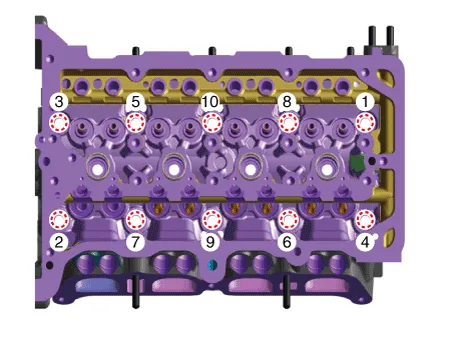

• Removing cylinder head bolts in an incorrect order may result in head warpage or crack.
• Use dodecagonal driver socket that has under 15mm(0.5906 in.) external diameter and longer than 75mm(2.9528 in.) cylinder to not have interference between cylinder head and dodecagonal driver socket when the cylinder head bolt removal.
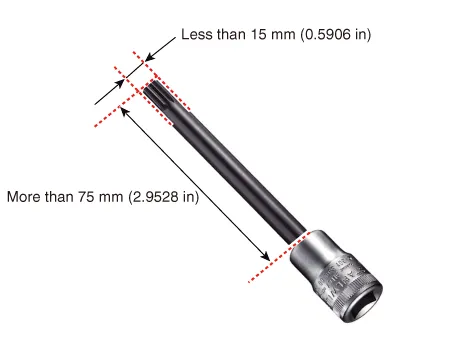

• A camshaft may rotate unstably, if the shape of the attached side of the carrier has altered by running into a cylinder head and the tool to detach a cylinder head bolt.
(2)Lift the cylinder head (A) from the cylinder block and put the cylinder head on wooden blocks.


• Be careful not to damage the contact surfaces of the cylinder head and cylinder block.
(3)Remove the cylinder head gasket (A).
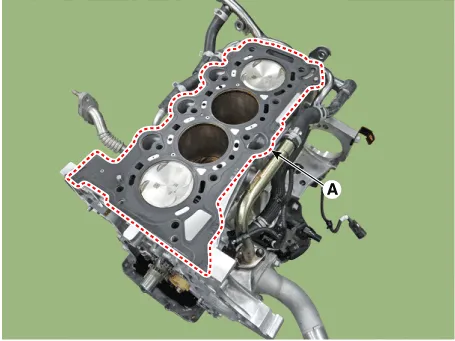

• Do not reuse the cylinder head gasket.
1.Remove the valves.
(1)Using the SST (09222-3K000, 09222-3K100), compress the valve spring and remove the valve spring retainer lock (A).
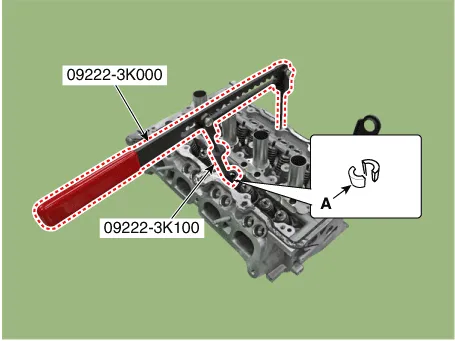
(2)Remove the retainer (A).
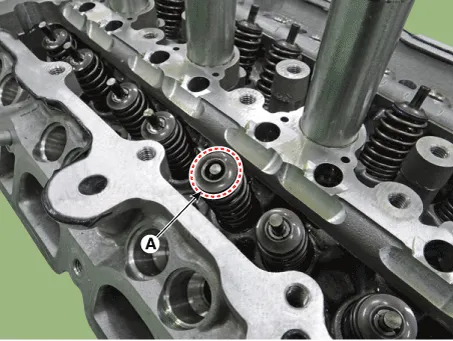
(3)Remove the valve spring (A).

(4)Remove the valve (A).
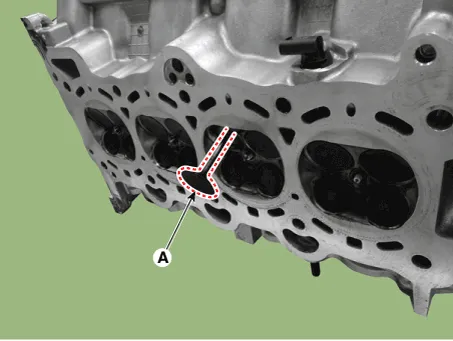
(5)Remove the valve stem seal (A) and valve spring seat (B).
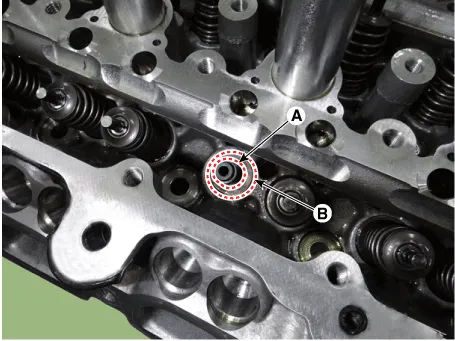

• Always use new valve stem seals.
Cylinder Head
1.Inspect for flatness.Using a precision straight edge and feeler gauge, measure the surface the contacting the cylinder block and the manifolds for warpage.
Flatness of cylinder head gasket surfaceStandard :Less than 0.05 mm (0.0020 in.) for total areaLess than 0.02 mm (0.0008 in.) for a section of 100 mm (3.9370 in.) x 100 mm (3.9370 in.)Flatness of manifold gasket surface (intake / exhaust)Standard : Less than 0.10 mm (0.0039 in.)
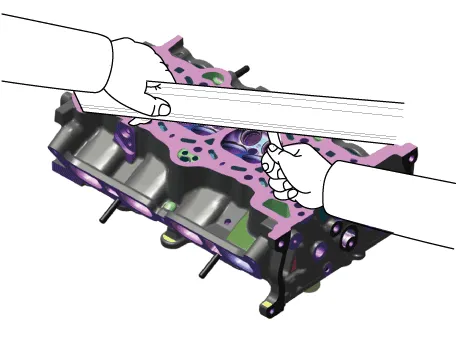
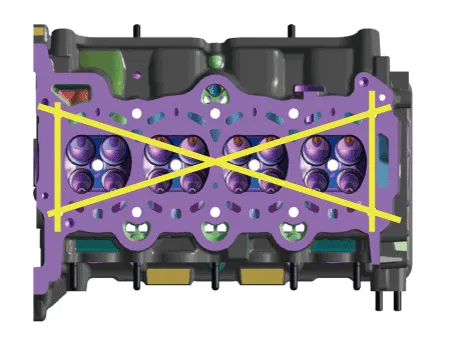
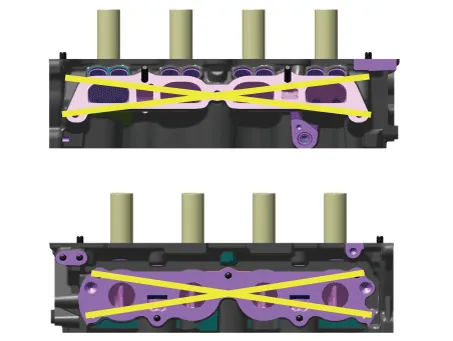
2.Inspect for cracks.Check the combustion chamber, intake ports, exhaust ports and cylinder block surface for cracks. If cracked, replace the cylinder head.
1.Inspect the valve stems and valve guides.
(1)Using a caliper gauge, measure the inner diameter of valve guide.
Valve guide inner diameter (Intake / Exhaust) :5.505 - 5.517 mm (0.2167 - 0.2172 in.)
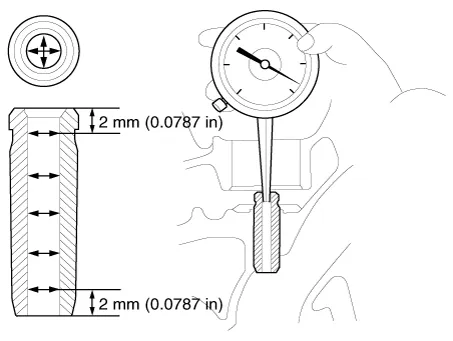
(2)Using a micrometer, measure the outer diameter of valve stem.
Valve stem outer diameterIntake : 5.465 - 5.480mm (0.2152 - 0.2157in.)Exhaust : 5.458 - 5.470mm (0.2149 - 0.2154in.)
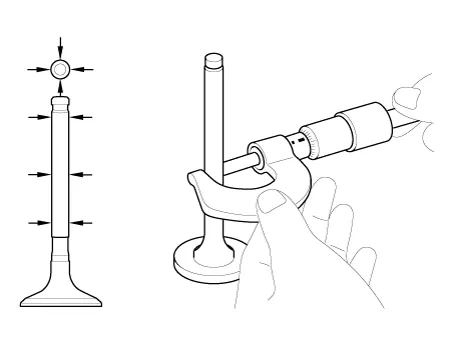
(3)Subtract the valve stem outer diameter measurement from the valve guide inner diameter measurement.
Valve stem- to-guide clearanceIntake : 0.025 - 0.052 mm (0.0010 - 0.0020 in.)Exhaust : 0.035 - 0.059 mm (0.0014 - 0.0023 in.)
If the clearance is greater than specification, replace the valve or the cylinder head.2.Inspect the valves.
(1)Check the valve is ground to the correct valve face angle.
(2)Check that the surface of valve for wear.If the valve face is worn, replace the valve.
(3)Check the valve head margin thickness.
Valve head thickness (Margin)StandardIntake : 0.70 mm (0.0276 in.)Exhaust : 0.91 mm (0.0358 in.)
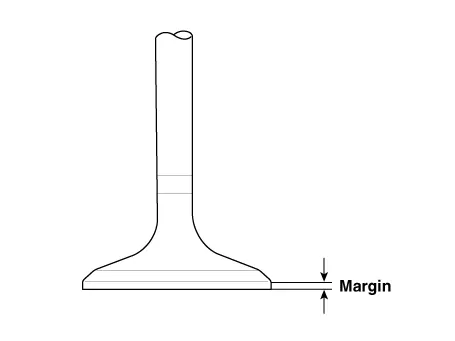
(4)Check the length of valve.
Valve lengthIntake : 112.84 mm (4.4425 in.)Exhaust : 122.83 mm (4.8358 in.)
3.Inspect the valve seats.
(1)Check the valve seat for evidence of overheating and improper contact with the valve face. If the valve seat is worn, replace the cylinder head.
(2)Check the valve guide for wear. If the valve guide is worn, replace the cylinder head.
4.Inspect the valve springs.
(1)Using a steel square, measure the out-of-square of valve spring.
(2)Using a vernier calipers, measure the free length of valve spring.
Valve springFree height : 50.00 mm (1.9685 in.)Out of square : Less than 1.5˚

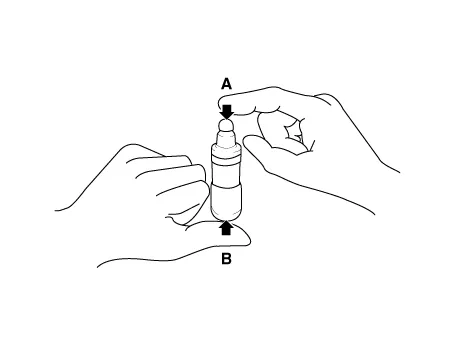
| Problem | Possible cause | Action | |||||
| 1. Temporary noise when starting a cold engine | Normal | This noise will disappear after the oil in the engine reaches the normal pressure. | |||||
| 2. Continuous noise when the engine is started after parking more than 48 hours | Oil leakage of the high pressure chamber on the HLA, allowing air to get in | Noise will disappear within 15 minutes when engine runs at 2000-3000 rpm. If it doesn’t disappear, refer to step 7 below. | |||||
| 3. Continuous noise when the engine is first started after rebuilding cylinder head | Insufficient oil in cylinder head oil gallery | ||||||
| 4. Continuous noise when the engine is started after excessively cranking the engine by the starter motor or band |
| ||||||
| 5. Continuous noise when the engine is running after changing the HLA |
|
6. Continuous noise during idle after high engine speed
Engine oil level too high or too low
Check the level of oil to refill or drain the oil.
Excessive amount of air in the oil at high engine speed
Check oil supply system.
Deteriorated oil
Check oil quality.
If deteriorated, replace with specified type.
7. Noise continues for more than 15 minutes
Low oil pressure
Check oil pressure and oil supply system of each part of engine.
Faulty HLA
Remove the cylinder head cover and press HLA down by hand. If it moves, replace the HLA.

• Beware of hot HLA.

• Thoroughly clean all parts to be assembled.
• Before installing the parts, apply fresh engine oil to all sliding and rotating surface.
• Always use new valve stem seals.
1.Install the valves.
(1)After applying engine oil to the valve stem seal, install a new valve stem seal using the special tool (09222-2B100).
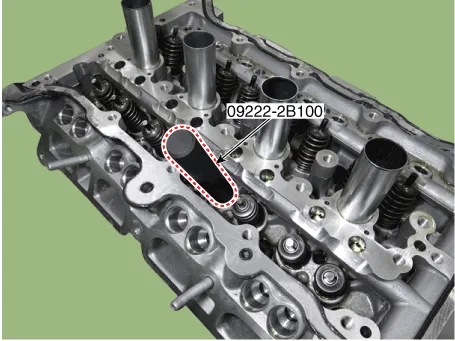

• Always use new valve stem seals.
• Incorrect installation of the seal could result in oil leakage past the valve guides.
(2)Install the valve spring seat (A).

(3)Apply engine oil to the entire outer surface of each valve stem and insert the valve (A) inside the valve guide.
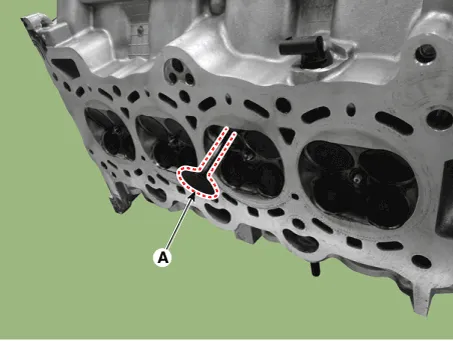
(4)Install the valve spring (A).
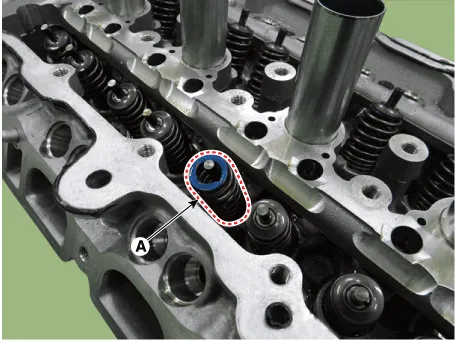
(5)Install the retainer (A).
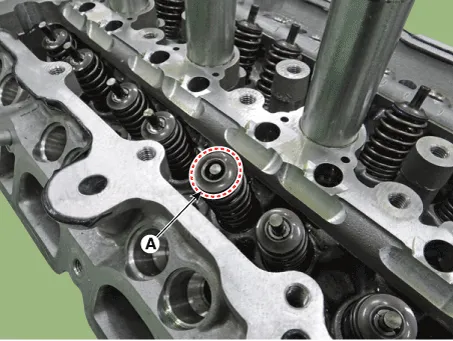
(6)Using the SST (09222-3K000, 09222-3K100), compress the valve spring and install the valve spring retainer lock (A).
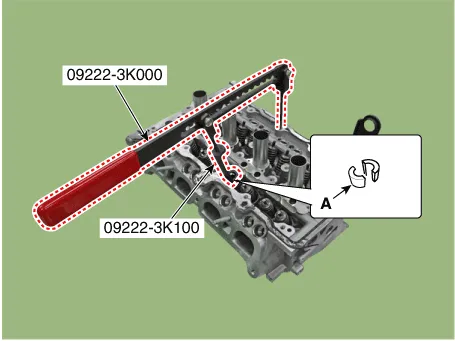

• Thoroughly clean all parts to be assembled.
• Always use a new cylinder head gasket and manifold gasket.
• Always use a new cylinder head bolt and cylinder head bolt washer.
• The cylinder head and exhaust manifold is a metal gasket. Take care not to bend it.
• Turn the crankshaft pulley so that the No. 1 piston is at top dead center.
1.Install the cylinder head.
(1)Remove hardening sealant, oil, dust, moisture and harmful foreign materials from the cylinder block and the cylinder head.
(2)Apply liquid sealant on the upper surface of the cylinder block.
Width : 2 - 3 mm (0.0787 - 0.1181 in.) Specification : LOCTITE 5900H / THREE BOND 1217H or above.
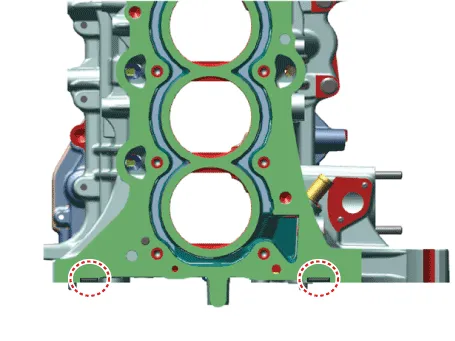
(3)Install the cylinder head gasket (A) to the cylinder block.
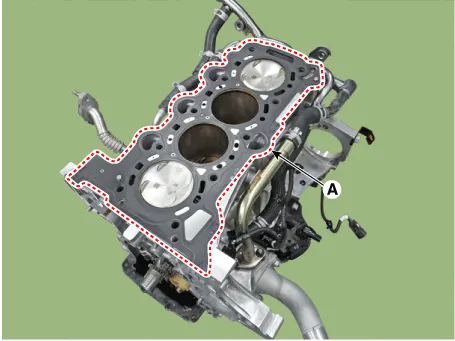

• Be careful not to change the install direction of gasket.
(4)Apply liquid sealant on the upper surface of the cylinder head gasket.
Width : 2 - 3 mm (0.0787 - 0.1181 in.)Specification : LOCTITE 5900H / THREE BOND 1217H or above.
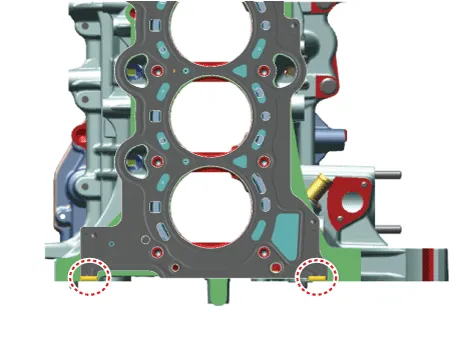
(5)Place the cylinder head (A) carefully not to damage the head gasket.
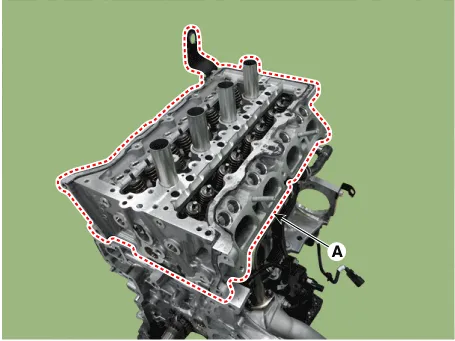
2.Install the new cylinder head bolts.
(1)Do not apply engine oil on the new cylinder head bolts.
(2)Recheck tightening torque 29.4 N·m (3.0 kgf·m, 21.7 lb·ft) of each cylinder head bolt, after installing a new plain washer and a new cylinder head bolt according to the tightening torque 29.4 N·m (3.0 kgf·m, 21.7 lb·ft) in procedure down below.Continuesly tighten with angle tightening torque(90°) following the procedure in picture below after tightening with angle tightening torque(90°) with no stop following the procedure down below.
Tightening torque :29.4 N.m (3.0 kgf.m, 21.7 lb-ft) + 90° + 90°
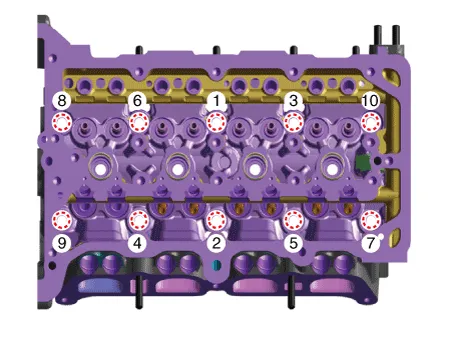

• Always use a new cylinder head bolt and cylinder head bolt washer.
• Assemble the cylinder head gasket and cylinder head within 5 minutes after applying liquid sealant.
• Remove the extruded sealant within 5 minutes after installing cylinder head bolts.
• When installing the cylinder head bolt, make sure where up/down direction of the cylinder head bolt washer part is headed and check if the chamber and round part of the washer is facing the head of the cylinder head bolt.
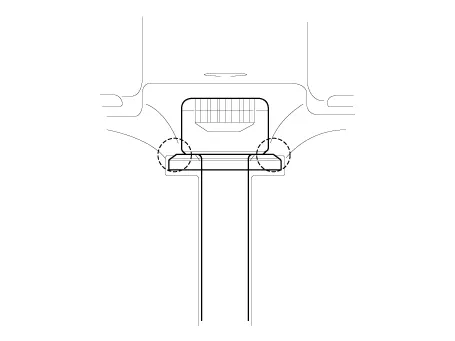
• Use dodecagonal driver socket that has under 15mm(0.5906 in.) external diameter and longer than 75mm(2.9528 in.) cylinder to not have interference between cylinder head and dodecagonal driver socket when the cylinder head bolt installation.
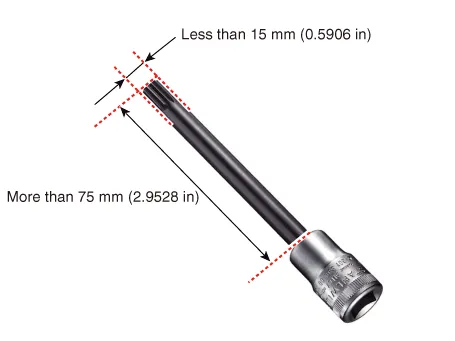

• A camshaft may rotate unstably, if the shape of the attached side of the carrier has altered by running into a cylinder head and the tool to detach a cylinder head bolt.
3.Install the hydraulic lash adjuster (HLA) (A) and swing arm (B).
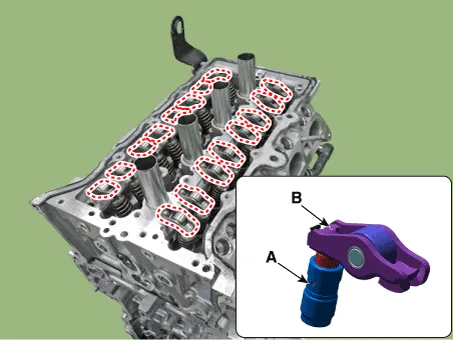
4.Install the cam carrier to the cylinder head.
(1)Remove hardening sealant, oil, dust, moisture and harmful foreign materials from the bottom surface of the cam carrier and top surface of the cylinder head.
(2)After applying liquid sealant on the bottom surface of the cam carrier, Continuous bead of sealant should be applied to prevent any path from oil leakage.
Width : 2.5 - 3.5 mm (0.0984 - 0.1378 in.)Specification : LOCTITE 5900H / THREE BOND 1217H or above.
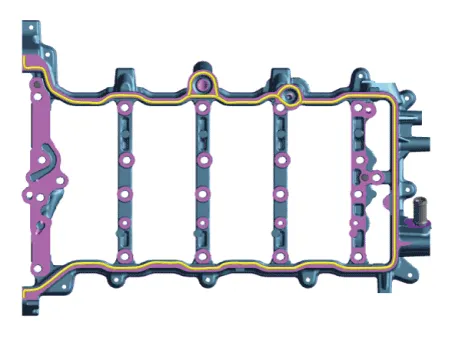
(3)The dowel pins on the cam carrier and holes on the cylinder head should be used as a reference in order to assemble the cam carrier in exact position.

• When installing the cam carrier to the cylinder head, make sure to prevent the sealant from entering the hole of the oil level gauge (A) and the positive crankcase ventilation (PCV).
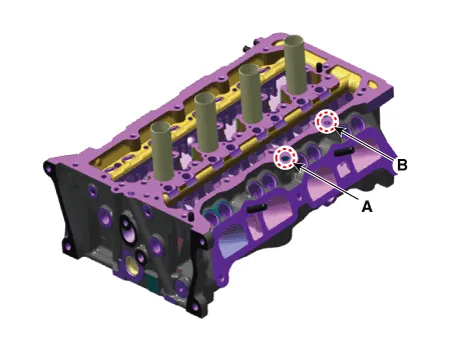
(4)Install the cam carrier (A).
Tightening torque : 18.6 - 22.6 N.m (1.9 - 2.3 kgf.m, 13.7 - 16.6 lb-ft)
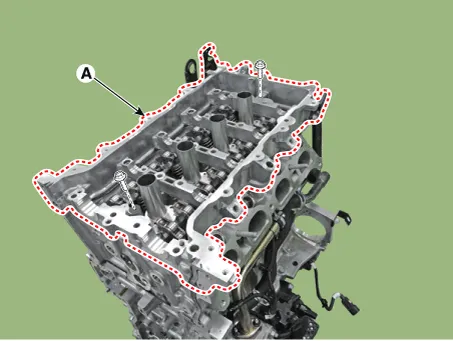

• Assemble the cam carrier within 5 minutes after applying sealant.
• Assemble the camshaft bearing cap within 5 minutes after assembling the cam carrier.
• The engine running or pressure test should not be performed within 30 minutes after assembling the cam carrier.
• After installing the cam carrier to the cylinder head, check whether there are sealants in the hole of the oil level gauge and the positive crankcase ventilation (PCV).
5.Install the intake CVVT & camshaft assembly (A) and exhaust CVVT & camshaft assembly (B).
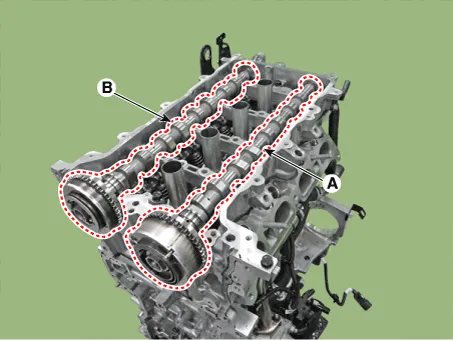

• When installing the intake and exhaust camshaft, spray the engine oil to the camshaft journal installing part (A) of the cam carrier.The amount of application should be enough to flow down both the front and back sides when it is applied to the center.
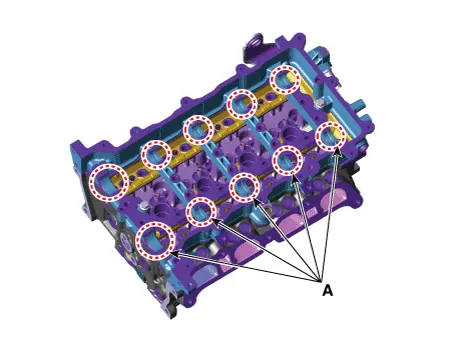
6.Install the camshaft front bearing cap and camshaft bearing caps.

• If there is enough engine oil on the camshaft front bearing cap and camshaft bearing cap installing bolt and bolt hole, tighten to the minimum required tightening torque.
• Apply engine oil the upper part of the intake / exhaust camshaft journal, then install the camshaft front bearing cap and camshaft bearing cap. The amount of application should be enough to flow down both the front and back sides when it is applied to the center.
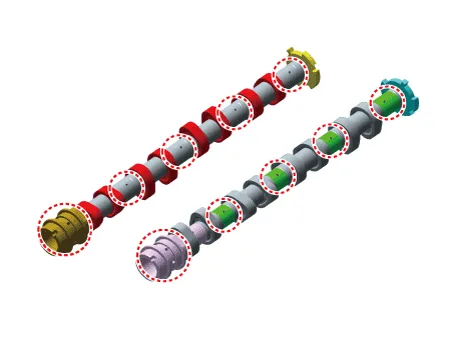
• When installing camshaft front bearing cap and camshaft bearing cap, a stable installation of a dowel pin (A) and a knock bushing (b) to the installing part of the bearing cap requires proper leveling.

(1)Install the camshaft front bearing cap (A) and camshaft bearing caps (B).
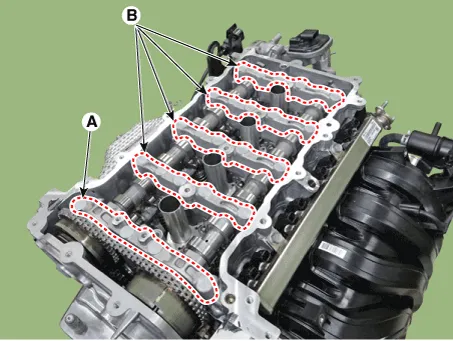
(2)Install the camshaft front bearing cap and camshaft bearing cap installing bolt with direction from back of engine to the front of engine according to the procedure at down below.
Tightening torque :1 STEP : 4.9 - 6.9 N.m (0.5 - 0.7 kgf.m, 3.6 - 5.1 lb-ft)2 STEP : 18.6 - 22.6 N.m (1.9 - 2.3 kgf.m, 13.7 - 16.6 lb-ft)
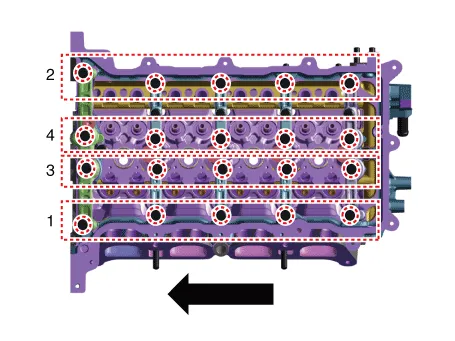
7.Install the other parts in the reverse order of removal.
8.Fill with engine coolant. (Refer to Cooling System - "Coolant")

• The coolant must be injected according to the integrated thermal management module (ITM) coolant filling method.
9.Refill engine with engine oil.(Refer to Lubrication System - "Engine Oil")
Other information:
Hyundai Accent (HC) (2017 - 2022) Service Manual: Specifications
- Specifications Fuel Delivery System ItemsSpecification Fuel TankCapacity43 lit. (11.4 U.S.gal., 45.4 U.S.qt., 37.8 Imp.qt.) Fuel Filter(built in Fuel Pump Assembly)TypePaper type Fuel Pressure Regulator(built in Fuel Pump assembly)Regulated Fuel Pressure323 ~ 363kpa (3.29 ~ 3.70kgf/cm, 46.79 ~ 52.63 psi) Fuel PumpTypeElectrical, in-tank type Driven byElectric motor Fuel Retrun SystemTypeReturnless Sensors Manifold Absolute Pressure Sensor (MAPS) ▷ Type : Piezo-resistive pressure sensor type▷ SpecificationPressure (kPa)Output Voltage (V) 10.Hyundai Accent (HC) (2017 - 2022) Service Manual: Control Shaft Complete
- Components 1. Control shaft complete - Removal 1.Set shift lever to N position. 2.Turn OFF ignition switch and disconnect the negative (-) battery cable. 3.Remove the air cleaner assembly and air duct.(Refer to Engine Mechanical System - "Air Cleaner") 4.Remove the battery and battery tray.(Refer to Engine Electrical System - "Battery") 5.
Categories
- Manuals Home
- Hyundai Accent Owners Manual
- Hyundai Accent Service Manual
- New on site
- Most important about car



